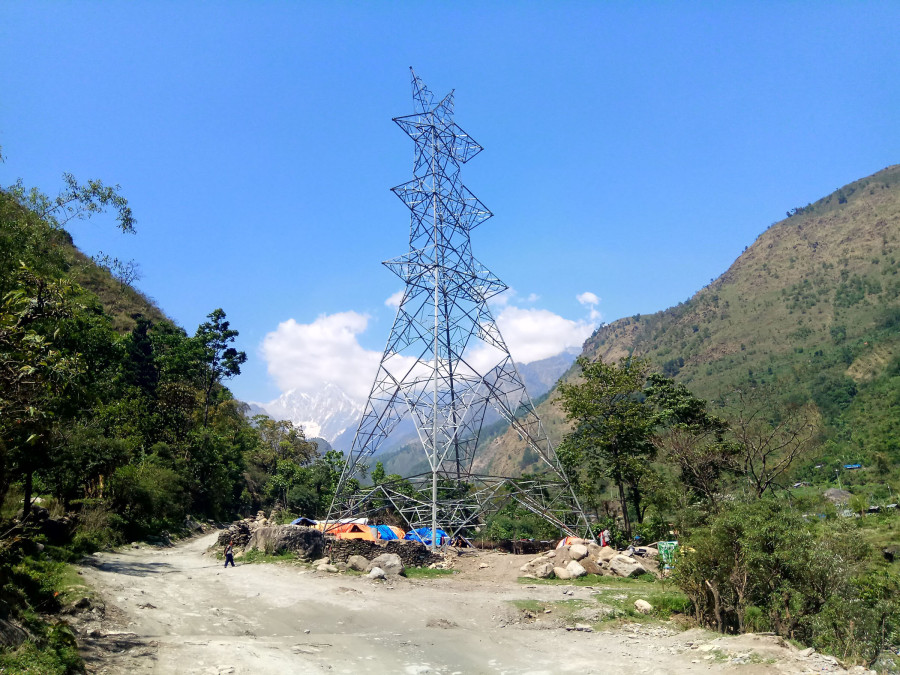Money
Kaligandaki Corridor Transmission Line Project hits snag
Electricity generated by hydel plants with a combined capacity of 28.6 megawatts is laying to waste .
Ghanashyam Khadka & Aash Gurung
The Kaligandaki Corridor Transmission Line Project has hit a setback owing to obstruction from locals of Annapurna rural municipality in Myagdi who have adamantly opposed the project’s plan of pulling high tension cables over the human settlement.
Following the obstruction, the project has not been able to fix the route for installing six transmission towers and officials say the project is currently carrying out a technical study on rerouting the power cables.
Earlier, work at the multimillion-dollar project had come to a grinding halt over disputes on the right of way of land falling under the under construction Beni-Jomson highway and Dana-Khurkot-Nawalparasi transmission line.
The Nepal Electricity Authority had assigned the construction works of Dana-Khurkot transmission line and substation to a TataCHINT, a joint venture of Indian firm Tata and Chinese developer CHINT, at a cost of Rs 2.90 billion.
The agreement between the state-owned power utility and the joint venture required works to be executed within 2018 November. A year on since the deadline, the developers have not been able to deliver.
“The high tension cables and road project have put the dense human settlement near the river bank at high risk. We have asked the project to revise the alignment of transmission lines such that the cables would pass near the settlement not right through it,” said Khadga Giri, a local.
At present, the contractor is installing cables at 108 towers in the 42 kilometre stretch in Dana-Khurkhot region. It needs to fix a total of 114 towers.
“The settlement is not at risk as we have executed works as per the approved environmental and social impact parameters,” said Chandan Ghosh, project chief. “As the gorge is narrow, the situation does not allow us to reroute the power lines far from settlements and the road.”
As per the Electricity Rules, 1993, the distance from a house to the power lines or nearby tree must be around 2 metres.
According to Ghosh, 80 percent of the works have been executed and the project office has plans to finish the task within December upon resolution of conflict.
The state-owned power utility plans to evacuate 940 megawatts of electricity generated by ten of operational and proposed hydel schemes in Mustang, Myagdi, Parbat and Baglung via the 220 kV power lines to Khurkot substation in Parbat and from Khurkot to Bardaghat in the southern plains.
Amid delays in building the power lines, electricity generated by hydel plants with a combined capacity of 28.6 megawatts is laying to waste with the schemes unable to convey power to the national grid.
Marshyandi Corridor at a snail’s pace
Mired by disputes, works at the 220 kV Marshyandi Corridor Transmission Line Project have failed to make substantial progress, four years after construction began.
The project with the deadline set for 2020 has not been able to set up physical structures and execute the contractor hiring process at some portions of the power lines.
The state-owned power utility is building a 112-kilometre long power line with endpoints at Manang and Chitwan with the capacity to evacuate 1600 megawatt of electricity.
In the first phase of the project, a 67-kilometre long transmission line stretching from Udipur in Lamjung to Bharatpur substation with 179 pylons is being built by Chinese developer Pinggao.
However, the power utility has reinvited bids for the construction of the substations at Udipur and Bharatpur after the selected contractor failed to appear with performance guarantee within 28 days of notification of contract award.
According to Chirantan Bikram Rana, project chief, the project office expects to enter into a contract with a construction company for building the substations within two months. “At present works related to digging foundations and procuring cables are being executed but the contractor for transmission lines has been dilly-dallying,” said Rana.
Also, the project has faced obstructions owing to disputes on the right of way in Palungtar in Gorkha.
“The energy ministry is expected to resolve the issue,” said Rana.
Locals and former prime minister Baburam Bhattarai have launched protests in the region after the power-utility routed the power lines through areas where the government had declared to build a smart city.
In the second phase, the project has proposed to build a 45-kilometre transmission line from Naso rural municipality in Manang to Udipur in Lamjung. The project is currently distributing land compensation and acquiring easement rights.
The 95-million euro national priority project, Marshyangdi corridor is funded by the European Investment Bank and the government.
Amid the delays in work execution, the locals have launched a campaign against the project accusing the power utility of building high voltage power lines without proper Free, Prior and Informed Consent (FPIC) of indigenous communities.
According to locals, the power utility has ignored the objections of the project-affected indigenous people while building power lines which pass over their homes, lands, forests and community spaces.
A struggle committee formed by the locals has also filed a complaint against the power utility at the European Investment Bank.
According to Chandra Bahadur Mishra, secretary of the struggle committee, the power utility should not route the power lines haphazardly and pay out 100 percent in land compensation as per the market value to acquire the easement rights.
In the wake of complaints filed by the FPIC & Rights Forum advocating for the rights of Lamjung communities, the Complaints Mechanism of the donor carried out an initial assessment and proposed a collaborative resolution process in July.
But the power utility refused to take part in a resolution process proposed by the Complaints Mechanism of the European donor citing that Nepal has its resolution process.




 16.12°C Kathmandu
16.12°C Kathmandu
.jpg)















